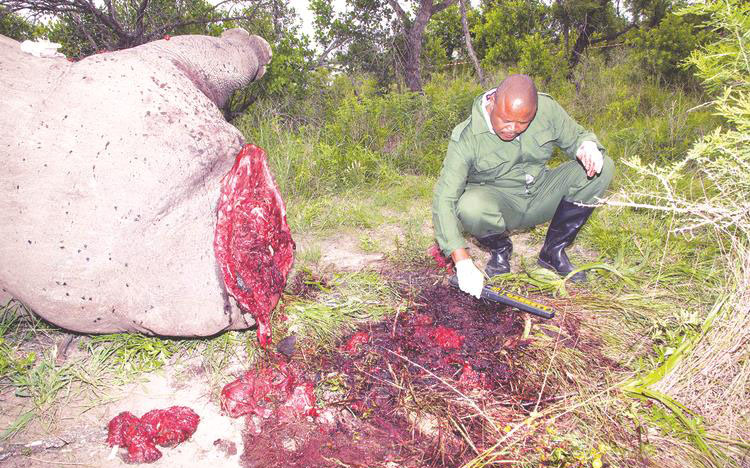How to save the rhino from extinction


DEHORNED . . . The ban on rhino horn trade is not working and scenes like these are likely to be repeated in most of the African rhino range states that include South Africa, Botswana, Namibia, Swaziland and Zimbabwe.
Emmanuel Koro Correspondent
I am sure by now Western countries’ animal rights groups who have continued to position themselves as “supreme” animal “lovers” should have sent condolence messages to the South African people, particularly the South Africa Department of Environmental Affairs, following the poachers’ ruthless killing of a total of 12 rhinos within a six-week period. All the rhinos were poached from iMfolozi Game Reserve in Kwazulu Natal, on Sunday July 2 and around May 17, 2017. An average of three rhinos were poached daily in South Africa in 2016.
Ironically, such intense and relentless rhino-poaching continues to happen while the world continues to think that the UN Convention on International Trade in Endangered Species of Wild Fauna and Flora (CITES) international ban on rhino horn will one day save the rhino. Sadly, the truth is that the ban in rhino horn trade is not working and will never stop rhino poaching.
Meanwhile, a curious and hardly noticeable eyebrow-raising trend has started to unfold amidst the rhino poaching crisis. It is becoming increasingly evident that it is only the poachers and the animal rights groups who are benefiting from the rhinos as long as the CITES international rhino trade ban remains.
While the ban is in force, the black market price of rhino horn is much higher than it would have been if trade ban was lifted, allowing for strictly controlled legal trade that would decrease the demand of the horn and also remove the poachers’ monopoly on rhino horn trade. Also curiously benefiting from the international ban in rhino horn trade are Western animal rights groups that continue to ask for and receive a lot of rhino “conservation” funding; as long as the rhino poaching crisis continues to increase.
The secret to saving the rhino lies not in international trade ban on its horn but in CITES permitting strictly controlled international trade in rhino horn. This will no doubt put both poachers and animal rights groups out of business. The poachers would almost immediately lose the black market for the rhino horn and animal rights would not be able to get donations when rhino poaching stops.
Sadly, CITES might not lift the international ban on rhino horn soon.
Meanwhile, the African range states (those that own rhino populations) might for years to come, continue to pay the costs of looking after the rhino without getting any meaningful benefits from it. These African rhino range states include South Africa (with the biggest rhino population in the world), Botswana, Namibia, Zimbabwe and Swaziland, and their rural communities neighbouring national parks and game reserves such as those next to the iMfolozi Game Reserve who are calling for a CITES strictly controlled international rhino horn trade.
With its secretariat in Geneva, Switzerland, CITES was established in 1975 in order to stop illegal trade in wildlife and wildlife products. CITES requires every member state that becomes a signatory to agree to abide by the majority vote of the parties (the signatories). This means that every member state is required to surrender its entire sovereign right to trade in its wildlife and their products and abides by whatever the CITES decide through a majority vote. Therefore, despite their wish and call for an CITES strictly controlled international trade in their stockpiled rhino horns, Namibia, South Africa, Swaziland cannot do so because the majority of CITES member countries continue to vote against such trade. It is becoming increasingly evident that animal rights groups have great influence on how CITES member countries vote. African countries do not have powerful pro-sustainable use NGOs to counter the animal rights’ endless opposition to rhino horn trade.
So what is the way out for African rhino range states and their rural communities, from this sad status quo where taxpayers’ money continues to be used to protect the endangered rhino, without tangible benefits?
In my view, we need to convince CITES member countries to try the South American vecuna conservation model. It originally involved the vecuna being poached for its skin and fur; during the CITES international ban in these products. The vecuna later survived poaching and its population increased dramatically, following the lifting of the CITES ban with benefits from the sale of its products going to the local communities.
Therefore back home in Africa, rhino conservation could never work until the African communities can sell their rhino horn just like the communities in South America are now selling their vecuna that has a similar history to the CITES rhino horn international ban but it is now being traded. Following CITES’ lifting of the international trade ban on vecuna skin and fur, the South American vecuna population has since increased from 5 000 about 40 years ago to a total population of 450 000 now.
The secret was in making the South American communities see the incentive to conserve the vecuna that they are now benefiting from through trade. Instead of poaching, they now sustainably shear the vecuna fur and have stopped shooting it for its skin and fur as happened in the past. This is exactly why I am arguing that the rhino horn should be harvested and traded without killing the rhino for it horn. Just like the vecuna did, if the rhino pays it stays.
- Emmanuel Koro is a World Bank International Award-winning environmental journalist based in Johannesburg, South Africa.










Comments